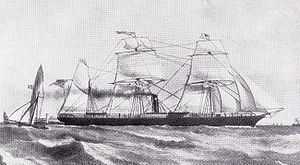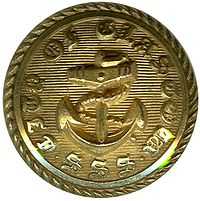SS City of Glasgow
 City of Glasgow | |
| Career (UK) | |
|---|---|
| Name: | City of Glasgow |
| Owner: |
1850: Tod & Macgregor 1850–54: Inman Line |
| Port of registry: | Glasgow |
| Route: |
1850 Glasgow – New York 1850–54 Liverpool – Philadelphia |
| Ordered: | 1849 |
| Builder: | Tod & Macgregor, Partick, Glasgow |
| Yard number: | 57 |
| Launched: | 28 February 1850 |
| Christened: | 28 February 1850 by Miss M. Galbraith [1] |
| Maiden voyage: | 16 April 1850 |
| In service: | 1850 |
| Out of service: | 1854 |
| Fate: | Lost at sea, March 1854 |
| General characteristics | |
| Type: | ocean liner |
| Tonnage: | 1,609 GRT |
| Length: | 227 ft (69 m) |
| Beam: | 34 ft (10 m) |
| Depth: | 25 ft (7.6 m) |
| Propulsion: | Single screw |
| Sail plan: | Three-masted barque |
| Capacity: | 137 cabin passengers as built. 400 steerage added later. |
| Crew: | 70 |

SS City of Glasgow of 1850 was a UK single-screw passenger steamship of the Inman Line, which disappeared en route from Liverpool to Philadelphia in January 1854. Based on ideas pioneered by Isambard Kingdom Brunel's SS Great Britain of 1845, City of Glasgow established that Atlantic steamships could be operated profitably without government subsidy. After a refit in 1852, she was also the first Atlantic steamship to carry steerage passengers, representing a significant improvement in the conditions experienced by immigrants.[2]
Development and design
Built by Tod & Macgregor of Partick, Glasgow and launched in 28 February 1850, City of Glasgow initially carried 44 first class and 85 second class passengers along with 1,200 tons of cargo. Her iron hull considerably reduced repair costs incurred by the wooden-hulled steamships of the day, and the use of a propeller instead of paddle wheels allowed more space for passengers and cargo. City of Glasgow was especially economical because she was not built for speed; her best time across the Atlantic was 14 days, 4 hours, almost 4 days longer than Cunard Line's Asia, the record holder in 1850. While the City of Glasgow's two lever-beam engines of 350 horsepower produced a moderate 9.5 knots, her coal consumption was only 20 tons per day, compared with 76 tons for Asia.[3]
Service history
She made five voyages on the Glasgow – New York service on Tod & Macgregor's own account and sailed on her maiden voyage on 15 April 1850. City of Glasgow was the first steamship to travel from Glasgow to New York. William Inman, a business partner of the line of sailing packets, persuaded his other partners to expand their line by buying the advanced new steamship. On 5 October 1850, she was purchased by the newly formed Liverpool and Philadelphia Steam Ship Company (also known as the Inman Line) and moved to the Liverpool – Philadelphia route from December 17, 1850. In 1852, the company entered the immigrant trade and City of Glasgow was refitted to accommodate an additional 400 third class passengers in her holds.[2]
City of Glasgow left Liverpool on 1 March, 1854, with an estimated 480 passengers and crew, but was never heard of again. Her fate remains a mystery to this day.[4] It was reported that a portion of the bow of a ship, bearing the name "City of Glasgow" in gilded letters, washed ashore at Ballochgair near Campbeltown on 25 October 1854.[3]
See also
- List of ocean liners
- List of shipwrecks
- List of United Kingdom disasters by death toll
References
- ↑ Direct Steam Communication Between Glasgow and New York: Launch of the City of Glasgow, Glasgow Herald, March 1, 1850
- ↑ 2.0 2.1 Gibbs, CR Vernon (1957). Passenger Liners of the Western Ocean: A Record of Atlantic Steam and Motor Passenger Vessels from 1838 to the Present Day. John De Graff. pp. 112–114.
- ↑ 3.0 3.1 Transactions of the Glasgow Archaeological Society. James MacNab. 1859. p. 68.
- ↑ Fox, Stephen (2003). Transatlantic. HarperCollins. pp. 182–184. ISBN 0-06095549-X.